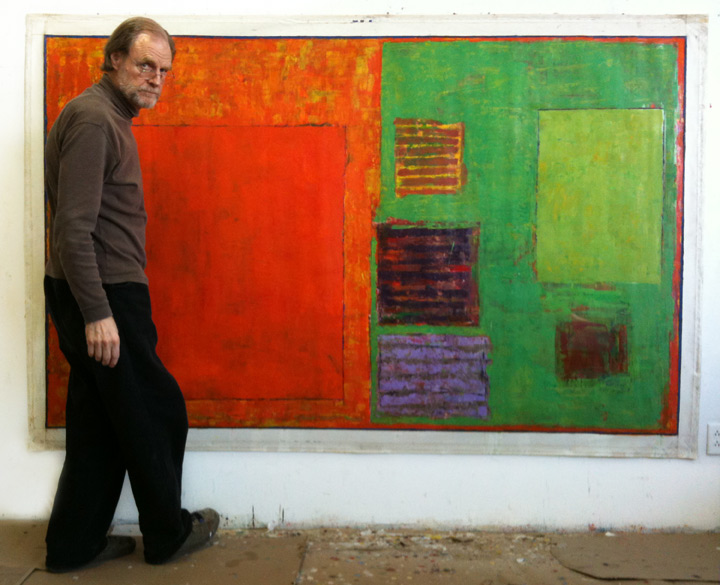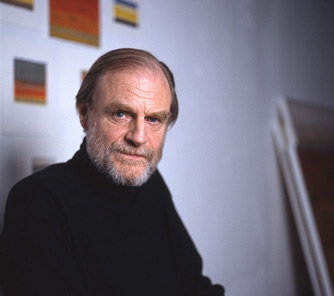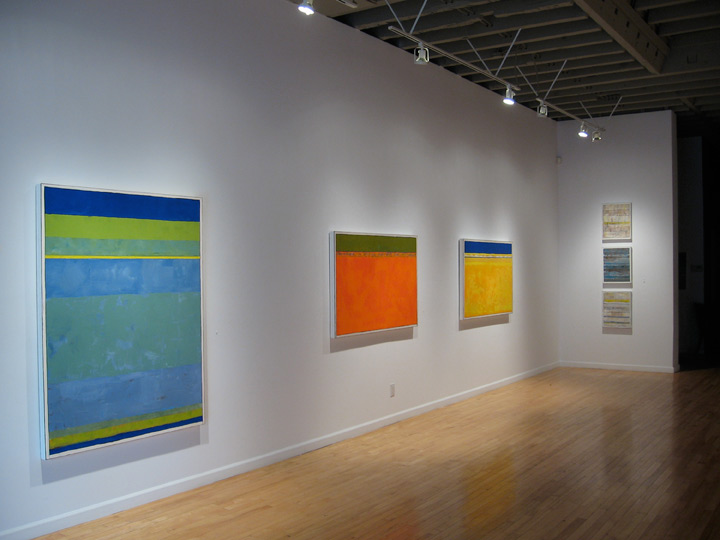 |
|
||||||||||||||||||
Montreal Gazette - Saturday, March 5, 2011 David Sorensen drawn by Montreal scene
MONTREAL - David Sorensen, one of Canada’s most dedicated artists, painted the Canadian canvas with a natural feel for colour, space, visual structure and a great searching spirit. Always open to new influences, Sorensen – who died last month – established a cultural liaison with Mexico early on, which remained a constant throughout his life. His first solo show was held at the Turok-Wasserman Gallery in Mexico City (1964). Visits to Mexico City, Lake Chapala and Guadalajara inspired vivid, colourful paintings. Dutch sculptor Peter Knigge introduced Sorensen to the Mexican sculptor Zuniga. Referring to the Mexican experience, Sorensen commented, “To me there is still this celebration worth the paint. And it’s about an open door that the artist used to call muse. I’m tapping into something new to me, and that enables a multi-view of the inner voice.” Of his Estela series he commented that they came “straight from an unmediated place.” Sorensen married Bella (née Hernandez) in Acapulco on Canada Day 1974, after three months of courting each other, and were inseparable from then on. Through much of his professional life was spent in Quebec, early influences were definitely West Coast. He went fishing with father Clancy Sorensen, and had a Gordon Smith painting on his bedroom wall. His mother was an artist, as is his daughter, Verona.
A trip through Europe in 1959 and the New American Painting show Sorensen saw in Europe set him on his life’s course. Jackson Pollock, Mark Rothko and William de Kooning were the mainstays in that show. During his one-year hiatus, sitting on the steps of the Parthenon, that classic emblem of civic democracy, Sorensen finished reading Jack Kerouac’s On the Road. The European exposure inspired Sorensen to enrol in the Vancouver School of Art under Jack Shadbolt and Jack Harman from 1960 to 1964. A course in carving with Bill Reid during the summer was his introduction to sculpture. Arthur Erickson, with whom Sorensen studied architecture at the University of British Columbia in 1958, inspired Sorensen to build his first real home in the Eastern Townships. It was direct contact with nature that brought him to move from Montreal to the Eastern Townships in 1977. The culmination of research into alternative technologies, his self-designed solar house is a monument to integration with habitat, bordered as it is by a stream and set amid forest and countryside. Using the proceeds from his first Montreal solo show at Espace 5, Sorensen built his family home, using British Columbia fir beams. A curious pod-like sculpture in the garden worthy of Buckminster Fuller was transformed into an experimental greenhouse, a sign of the times. An old barn provided the studio, though winter heating was something to contend with. The cultural scene in 1960s Montreal drew Sorensen like a magnet. Personalities like sculptor Armand Vaillancourt, originally from Black Lake; Jean-Paul Riopelle, who achieved success with Galerie Maeght in Paris; Leonard Cohen; and Serge Lemoyne (with whom Sorensen held a two-person show at the Musée d’art contemporain in 1970) were a few of the countless free spirits flourishing in Montreal’s colourful, historic, low-rent environment. From his St. Henri studio, Sorensen produced the sculpture Growth exhibited at the Youth Pavilion for Expo 67. He was nourished by the Montreal arts scene, and friends like Martin Dufour, originally from the Gaspé; Roger Vilder, who now lives in France; Morton Rosengarten and Brian Stevens, and went on to exhibit at Expo 67’s Youth Pavilion. Exhibiting at Montreal’s Saidye Bronfman Centre with New Montreal Sculpture (1971), Sorensen livened the show up by putting a sign near his flexible sculptures that read, “You’re getting between my art and my art forms!” At the Rubber show at Véhicule Art (1972), Canada’s first artist-run gallery, viewers were encouraged to move the flexible sculptures. Teaching fine arts at Bishop’s University in Lennoxville (1981-2000) provided a base for an ongoing career as a painter. Just as the Montreal scene inspired Sorensen, he likewise influenced and gave his support to younger painters in their ongoing quest to develop a language of painting. Displaced Arc (1984-86), one of his most engaging sculptures, was originally commissioned for the University of Sherbrooke and is now at the Fondation Armand Bombardier in Valcourt.
Sorensen held significant shows that consolidated his career. The Corner series (1983-84), exhibited at the Theo Waddington Gallery in Montreal in 1984, moved his art into the public eye. Created using a spatula and paintbrush, Sorensen’s Havana series, resulting from a visit to Cuba in 1999, are lively paintings that engage the rich textural atmospheres of that place. Major shows included Asian View (1993), held at Tokyo’s Canadian embassy, in Manila at the Metropolitan Museum and in Hong Kong at the Touchstone Gallery; Abstraction from Here to Now at the J. Armand Bombardier Foundation in Valcourt in 2001; Suite de l’Estrie at the Sherbrooke Museum (2003); and Intimacy of Light (1959-2005) at the Musée du Bas St. Laurent in Rivière du Loup (2006). A show at Espacio Mexico in Montreal last year, First Decade Horizons, continued the grid-like structures with thick textural coloured surfaces that had been so popular throughout Sorensen’s career. An original in his own right, influences on Sorensen’s painterly style included Richard Diebenkorn, Franz Kline, Peter Aspel and Henri Matisse. As his painting matured, flowering and developing, the formal abstract origins merged with a more sensual, textural immediacy, a quality decidedly different from Quebec’s Automatiste painters. Exhibiting internationally in France, Switzerland, Italy, Japan, China and the United States, Sorensen remained committed to the Montreal scene that helped establish his name. He was elected to the Royal Canadian Academy in 1996, and in 2002 was named professor emeritus at Bishop’s University. Near the end, Sorensen spent time reading his favourite authors – Kahlil Gibran, John Ruskin, Matsuo Basho, Rumi and Rilke’s Letters to painter Paul Cézanne. In a quiet moment, his daughter Verona asked Sorensen what his thoughts were about death. In character, David replied: “I’m curious.” When he passed away in bed at his Montreal home, his wife Bella, son Miguel and daughter Verona were next to him. Sorensen’s spirit lives on in all those he knew and loved. The cremation that followed was a Viking-like departure worthy of his Norwegian roots. Yellow, orange and red rose petals were collectively scattered by his loved ones in the casket, before the ship moved into fire before the final transformation. The journey continues as the memories and experiences we all shared with Sorensen live on. Through the medium of his art, a bridge is built between inner sensation and outer world experience, illusion and reality, what we cannot see and what we see, life and afterlife. David Gary Sorensen, born in Vancouver on May 30, 1937, died in Montreal on Feb. 17. For more information, including details on an upcoming memorial, visit http://www.davidsorensen.com. John K. Grande is a Montreal poet, writer and the author of Art Nature Dialogues (SUNY Press) and Dialogues in Diversity: Art from Marginal to Mainstream (Pari Publishing). Visit www.grandescritique.com. Read more: |
||||||||||||||||||


